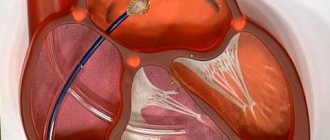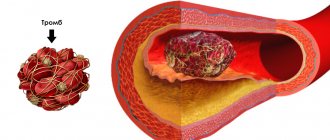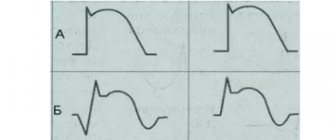The first 12 weeks after conceiving a child
is a period of active growth and development of the embryo, so managing pregnancy in the 1st trimester under the supervision of a qualified and caring obstetrician-gynecologist can be the best solution for parents and baby. In this article we will look in detail at what is special about this period, why it is very important to take care of the health of mother and child now, and what is included in the program of professional pregnancy management in the 1st trimester in our clinic.
Causes
The pathogenesis of tachycardia in pregnant women has not been sufficiently studied to date. During the period of bearing a child, numerous changes occur in a woman's body. It is generally accepted that attacks of rapid heartbeat in the absence of organic pathology are caused by hormonal fluctuations. During pregnancy, the body produces a large amount of substances that activate the sympathetic system. When the amount of such hormones begins to exceed a certain level, tachycardia may develop. Other causes of heart palpitations during pregnancy include:
- increase in a woman’s body weight;
- anemia;
- hypovitaminosis;
- acceleration of metabolism;
- water and electrolyte disturbances against the background of severe toxicosis;
- change in the position of the heart in the last weeks of gestation;
- use of certain medications.
Increased heart rate in early pregnancy
Tachycardia at the beginning of pregnancy appears infrequently and can be caused by external factors. These are excessive physical activity, stress, smoking. If there are no external causes, but the pulse is off the charts, most likely the cause lies in a disease of the cardiovascular system. Such a case is a serious cause for concern. You should immediately seek medical help in the following cases:
- chest pain is felt;
- headache and nausea;
- the heart beats irregularly.
If an attack of rapid heartbeat occurs, but does not cause any particular discomfort, you need to perform the following simple steps:
- take a comfortable position;
- close your eyes for 2 minutes;
- inhale and exhale slowly.
After this procedure, the body will relax, and after a few minutes the heartbeat will return to its previous rhythm. But you shouldn’t start physical activity right away; it’s better to stock up on positive emotions, for example, read your favorite book.
Risks
Tachycardia during pregnancy is considered a physiological phenomenon. Attacks of rapid heartbeat accelerate blood flow through the vessels, which helps provide the fetus with nutrients and oxygen. However, an increase in heart rate to 120 beats per minute and the appearance of corresponding symptoms may indicate a pathology caused by cardiac or extracardiac causes. Tachycardia in pregnant women requires monitoring. It is important to distinguish a physiological norm from a pathological rhythm disorder that requires urgent treatment.
Deadly pregnancy complication: who is at risk
Monitoring the course of pregnancy is 50% highly artistic pasting tests into a card, and 50% - performing completely routine procedures: weighing, measuring the abdomen with a centimeter tape, examining the limbs and measuring blood pressure (BP). On two hands. Necessarily. From an early date.
Once upon a time, the USSR managed to significantly reduce maternal mortality rates in a simple but surprisingly effective way.
A midwife was stationed in every small settlement who could measure a pregnant woman’s blood pressure and independently boil a portion of urine in order to find protein in it.
Simple midwives in the USSR and highly educated obstetrician-gynecologists in modern Russia are doing the same thing - persistently looking for signs of impending preeclampsia - a formidable and deadly complication of pregnancy.
What is preeclampsia?
This is a serious complication of pregnancy, in which the functioning of the entire body is seriously disrupted. In addition to the increase in blood pressure, a large amount of protein appears in the urine, the number of platelets in the blood decreases, the functioning of the liver and kidneys suffers, epigastric pain, visual disturbances, and severe headaches appear.
The condition can rapidly progress and lead to convulsions with loss of consciousness - eclampsia.
Preeclampsia begins after 20 weeks of pregnancy. The sooner, the more dangerous. Preeclampsia that develops before 32 weeks of pregnancy is considered early; pregnancy always ends prematurely, because attempts to preserve it can kill both mother and child.
Sometimes preeclampsia develops in the postpartum period, which is why obstetrician-gynecologists never relax.
Why is this happening?
Science still cannot give an exact answer to this question, despite the fact that the pathogenesis of the disease is well studied.
In some cases we can predict the development of the disease, but almost never we can prevent it.
At risk:
- primigravida;
- women who had preeclampsia in a previous pregnancy;
- preeclampsia in relatives (mother, sister);
- women who suffered from arterial hypertension before pregnancy or experienced an increase in blood pressure for the first time before 20 weeks;
- women with a history of kidney disease;
- women with diabetes mellitus, autoimmune diseases (systemic lupus erythematosus, scleroderma, antiphospholipid syndrome), thrombophilic conditions;
- obese women;
- women aged 40+ (another hello to all fans of the idea of delayed motherhood);
- multiple pregnancies;
- pregnancy after IVF
What is the child's risk?
Preeclampsia may require emergency delivery at any stage of pregnancy. This is often the only way to save the mother's life.
Severe prematurity in a newborn is a heavy burden that can affect the rest of a person’s life. Despite the breakthrough successes of modern neonatology, which has made it possible to nurse 500-gram babies, the mortality rate among premature babies is very high.
What does a woman risk?
Women who experience preeclampsia are likely to experience the condition in each of their pregnancies, with subsequent preeclampsia always more severe than the previous one.
Despite the fact that preeclampsia goes away with pregnancy, the risks of developing cardiovascular diseases, hypertension, stroke and heart attack remain.
Without adequate help, you may develop eclampsia, a severe seizure disorder similar to epilepsy. Acute renal failure, pulmonary edema are rapidly increasing, stroke or myocardial infarction, placental abruption, sudden intrauterine fetal death, retinal detachment with loss of vision can occur.
What is HELLP syndrome?
HELLP syndrome was first described in 1954. This is an abbreviation made up of the first letters: hemolysis - intravascular destruction of red blood cells (Hemolysis), increased activity of liver enzymes (Elevated Liver enzymes) and thrombocytopenia (Low Platelet Count).
This serious and potentially fatal condition is accompanied by severe blood clotting disorders, necrosis and rupture of the liver, and cerebral hemorrhages.
Dangerous symptoms
You should immediately consult a doctor if swelling appears on the face and hands, headaches that do not go away after taking conventional medications, blurred vision - blurred vision, “veil and fog”, flashing “spots” before the eyes.
Preeclampsia can manifest itself as pain in the epigastric region, right hypochondrium; nausea and vomiting in the second half of pregnancy, difficulty breathing are dangerous. A sudden weight gain (3-5 kg per week) may be a warning sign.
Preeclampsia is not mild
The most difficult thing for an obstetrician-gynecologist is not to panic ahead of time. Sometimes the situation allows you to delay time a little to allow the fetal lungs to ripen.
Up to 34 weeks, corticosteroids are administered to prevent respiratory distress syndrome. Sometimes the situation quickly worsens and requires immediate action and delivery.
How to prevent preeclampsia?
Unfortunately, doctors can predict many obstetric complications, but cannot prevent them. Over the years of research, a long list of disappointments has accumulated. The bed-rest regimen (resting in a lying position during the day), limiting table salt, fish oil or taking garlic tablets will definitely not help prevent the development of preeclampsia.
Neither taking progesterone medications, nor using magnesium sulfate, nor taking folic acid, nor using heparins, including low molecular weight ones (Clexane, Fraxiparin) is not a preventive measure. However, all of these drugs can be used during pregnancy for other purposes.
If the risk of preeclampsia is high, your doctor may suggest taking acetylsalicylic acid daily after the 12th week of pregnancy.
Pregnant women with low calcium intake (<600 mg per day) are advised to take supplemental calcium in the form of medications.
The best thing you can do is take care of prevention before pregnancy. Hypertension should be well controlled before conception.
Obesity requires weight loss, diabetes requires compensation and reliable control. Unfortunately, this is the right but difficult path.
Most often, women come into pregnancy with a whole bunch of problems that require urgent solutions.
Obstetricians and gynecologists around the world continue to measure blood pressure. On two hands. On every visit. And they ask you not to forget to regularly take a general urine test. This is a life-saving strategy.
Oksana Bogdashevskaya
Photo depositphotos.com
The opinion of the author may not coincide with the opinion of the editors
Treatment
The feasibility of treating tachycardia is assessed based on the results of an examination of the pregnant woman. If palpitations are physiological and transient, the doctor may recommend lifestyle changes and eliminate psycho-emotional stress. According to indications, sedatives approved for use during pregnancy may be prescribed. If tachycardia is associated with cardiac or endocrine pathology, drug treatment is selected by the appropriate specialist.
Draw your attention to! This article is not a call for self-medication. It is written and published to improve the reader's knowledge about his own health and understanding of the treatment regimen prescribed by the doctor. If you experience similar symptoms, be sure to seek help from a doctor. Remember: self-medication can harm you.
How to understand that a condition threatens your health
In the first trimester, tachycardia rarely occurs in a pregnant woman, and most often it is associated with the manifestation of early toxicosis. But perhaps this is a sign of a hidden disease. Both can be dangerous for both mother and child; a doctor’s consultation will not be superfluous. In the case of a physiological increase in heart rate, there is no threat to a pregnant woman.
A pathological malfunction of the sinoatrial node indicates the presence of the following abnormalities:
- the heart cannot withstand the increased load upon the birth of the fetus;
- anemia;
- arterial hypotension;
- reflex reaction of the myocardium to compression;
- nervous disorders;
- toxicosis of pregnant women;
- taking certain medications;
- endocrine diseases (in particular, thyrotoxicosis);
- imbalance between maternal energy needs and nutrition;
- water-electrolyte imbalance.
In the later stages of pregnancy, rhythm disturbances often have a natural (physiological) explanation: the uterus grows, the fetus increases in size and requires increased nutrition and oxygen supply. Seizures should not frighten a pregnant woman, but extra caution and attention to your health will not hurt: even a seemingly insignificant deviation from the norm can affect the outcome.
Complications
- Delayed fetal development.
- Premature birth or miscarriage.
- Death of the fetus in the mother's stomach.
- Difficult birth.
The Right Action
Tachycardia within 85-95 beats per minute does not cause pain or discomfort. Many women feel weakness and shortness of breath, which disappear after rest. An increase in heart rate above 100-120 beats during pregnancy is dangerous. This can lead to severe lack of air and fainting.
If you feel your heart beating too fast, try to calm down. Stop physical activity, lie down, breathe slowly and deeply, open a window for fresh air, drink a glass of water. In most cases, this will be enough to cope with the attack.
The “Square” breathing exercise helps a lot. It is necessary to proceed according to the following scheme:
- Inhale for 5 seconds (this is an average, you will have to experiment to find out your norm).
- Hold your breath for 5 seconds.
- Exhale for 5 seconds.
- Hold your breath again for the same amount of time and then repeat this cycle several times.
The following autonomic reflexes of the vagus nerve can also be used to reduce the heart rate:
- lightly press on the eyeballs several times - after this, the heart rate should return to normal;
- run the tip of your tongue across the roof of your mouth 7-8 times, this also calms your heartbeat.
Experimentally determine the best method and use it to stop attacks of sinus tachycardia. If there is no effectiveness and discomfort persists, call a doctor. Wherein:
- Lie down or sit down while waiting for the doctor.
- If tachycardia appears while lying on your back, change position, turn on your left side, and place a pillow under your back.
- Washing with cool water helps normalize your pulse.
- If you feel dizzy, take a semi-sitting position with a pillow under your feet.
- Do not take medications without a doctor's prescription.
What to do for prevention
- Completely stop smoking, drinking alcohol, energy drinks, and caffeinated coffee;
- strong black and green tea - in small quantities;
- physical activity should be moderate, without sudden and intense movements;
- During pregnancy, you should not run or lift weights;
- Slow walks in the fresh air and swimming are recommended;
- nutrition should be balanced, with sufficient protein, fat and carbohydrates;
- to prevent dehydration, you should drink at least 2 liters of fluid per day;
- A night's rest of at least 8-9 hours of sleep, and a daytime rest of 30-60 minutes are required.









